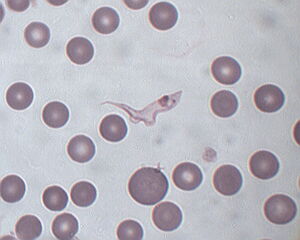
Trypanosoma brucei: trypomastigote in the blood. Taken by H. Considine at UVM

Life Cycle from CDC web page. www.dpd.cdc.gov/dpdx/html/trypanosomiasisafrican.htm
This protazoan parasite is known to cause the disease African trypanosomiasis. This disease is otherwise known as the sleeping sickness because, in its later stages, it effects the central nervous system of its host causing them to have personality changes like daytime sleepieness with night time sleep disturbances.
Life Cycle[]
Vector: The tsetse fly, Glossina palpalis, ingests the trypomastigote from the blood of an infected human. It multiplies in the midgut of the fly and then migrates to the salivary glands. It undergoes its epimastigote stage in the salivary gland and multiplies. The metacyclic trypomastigote is then in the saliva and able to infect a human host.
Host: The tsetse fly bites a human and the metacyclic trypomastigote is injected into the host. The trypomastigote then resides in the blood and lymph where it then can invade the central nervous system. It will then continue to divide in the blood, lymph, and spinal fluid.
Transmission[]
This parasite is vectored by the tsetse fly, Glossina palpalis. The parasite, in its trypomastigote stage, is in the salivary galnds of the fly. It is transmitted to the human host when the fly bites the host.
Diagnosis[]
First Stage of Infection:
Parasite is in peripheral circulation due to a bite from the tsetse fly. The area will develop a chancre. Within the next 1-2 weeks the host develops a fever, headache, muscle and joint aches, and enlarged lymph nodes.
Second Stage of Infection:
Parasite crosses blood-brain barrier and infects the central nervous system. These symptoms inclue mental deterioration, and neurological problems such as sleepieness in the daytime and sleep distrubances at night. The host may also have progressive confusion, partial paralysis, problems with balance or walking, and hormonal imbalances.
Third Stage of Infection:
Death within 3 years, rarely a human host will live 6-7 years.
Treatment[]
As of now there is no known cure for T.bruci, and the course of treatment depends on the satge of the disease. However, thre are many scientists that are exploring possible treatments (see recent research).
The CDC recommends the drug Pentamidine to treat the first stage of the disease. They also recommend that Physicians consult the CDC for advice on diagnosis and treatment of the disease when they have a patient present any of the symptoms listed above.
www.cdc.gov/parasites/sleepingsickness/treatment.html
Prevention[]
Since there is no cure or vaccine for the disease, African trypanosomiasis, the only way to reduce the risk of contracting this parasite it by avoiding the tsetse fly that transmits it. It is reccommended by the CDC that you wear long shirts and pants that are a medium to heavy weight because the fly can penetrate lighter weight clothing. The fly is also attracted to dark or bright colors so wearing light colors is essential. They are also attracted to moving objects, so it is wise to inspect your motor vehicle before entering.
www.cdc.gov/parasites/sleepingsickness/prevent.html
Recent Research[]
A study by J. Bero et al. (2013) looks into antitrypanosomal compounds that are present in the dichloromethane leaf extracts of the Keetia leucantha tree (Bero, J. et al., 2013). Of the 27 different compounds, contained in the essential oils of the leaves, the one that showed the highest antitrypanosomal activity was ursolic acid (Bero, J. et al., 2013). Ursolic acid also showed inhibitory activity on the glycolytic enzyme (GAPDH) of T. brucei (Bero, J. et al., 2013). There were many other compounds showed further antitrypanosomal activity on the bloodstream forms of T. brucei but not the procyclic forms of T. brucei (Bero, J. et al., 2013). This study demonstrates the many benefits of this tree in treating the sleeping sickness disease (Bero, J. et al., 2013). I believe it also demonstrates how important it is to preserve our forests so we can increase the probability of finding remedies for other disease that plague our communities.
A different study, by Phillips, E.A. et al. (2013), evaluated the effects of the Indian and Chinese bitter melon on T. brucei bloodstream forms (Phillips, E.A. et al., 2013). The bitter melon has been shown to have anti-tumor effects, and normally agents that have anti-tumor effects will also decrease the growth of T. brucei (Phillips, E.A. et al., 2013). The extracts were shown to promote rapid lysis of the parasite, and also caused the parasite to accumulate in the G2-M phase of their cell cycle (Phillips, E.A. et al., 2013). This suggests that the bitter melon extract is a very promising agent in the treatment of the sleeping sickness disease (Phillips, E.A. et al., 2013).
Resources[]
Bero, J., Beaufay, C., Hanaret, V., Herent, M.-F., Michels, P.A., Quetin-Leclercq, J. (2013). Antitrypanosomal compounds form the essential oil and extracts of Keetia leucantha leaves with inhibitor activity on Trypanosoma bruci glyceraldehydes-3-phosphate dehydrogenase. Phytomedicine, 20: 270-274.
Phillips, E.A., Sexton, D.W., Steverding, D., (2013). Bitter melon extract inhibits proliferation of Trypanosoma brucei bloodstream forms in vitro. Experimental Parasitology. 133:353-356.